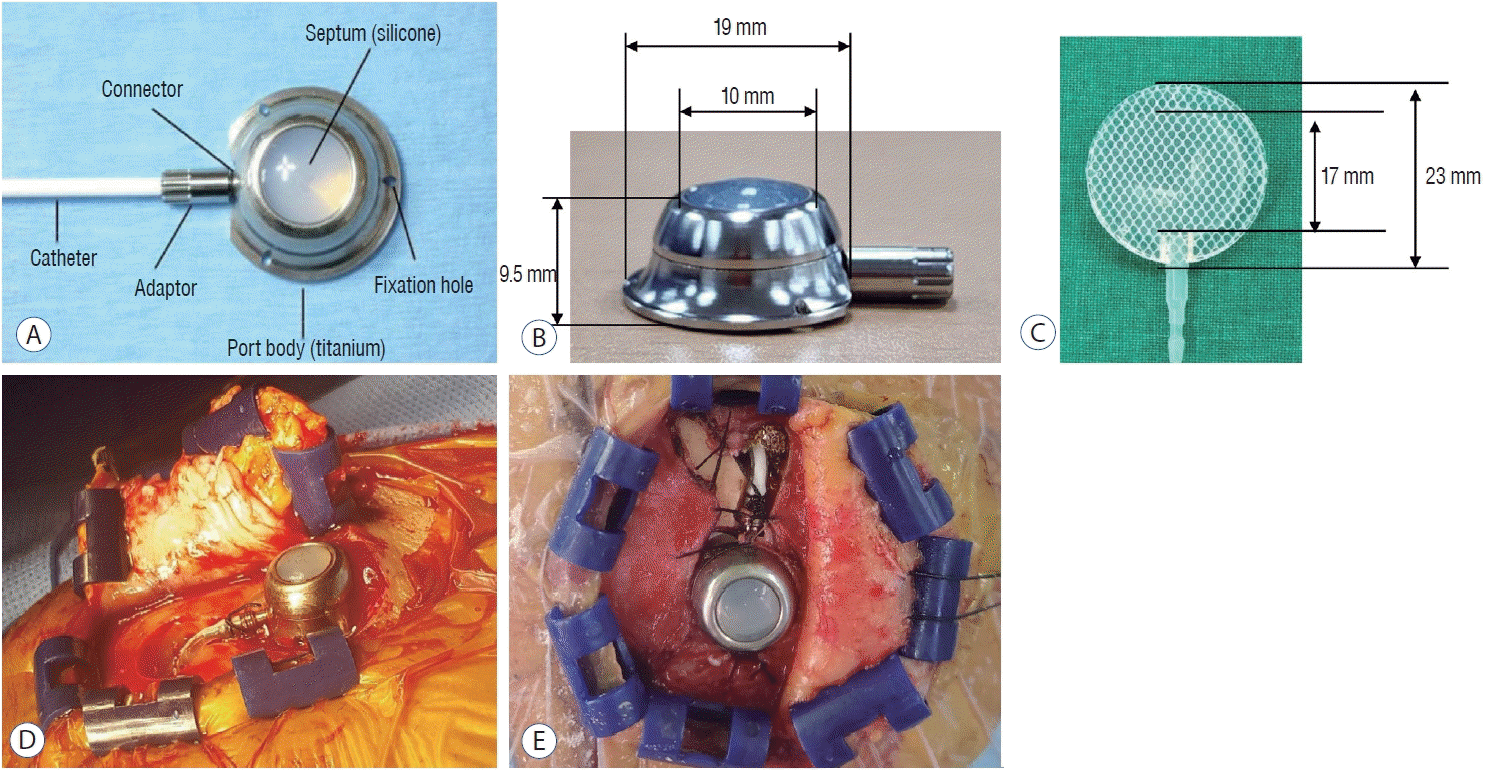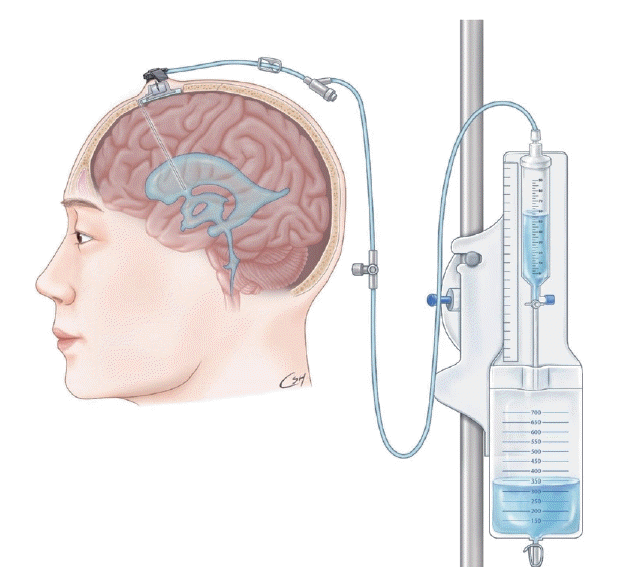1. Bleyer WA, Pizzo PA, Spence AM, Platt WD, Benjamin DR, Kolins CJ, et al. The Ommaya reservoir: newly recognized complications and recommendations for insertion and use. Cancer. 41:2431–2437. 1978.

2. Byun YH, Gwak HS, Kwon JW, Kim KG, Shin SH, Lee SH, et al. A novel implantable cerebrospinal fluid reservoir : a pilot study. J Korean Neurosurg Soc. 61:640–644. 2018.

3. Chamberlain MC. Leptomeningeal metastases: a review of evaluation and treatment. J Neurooncol. 37:271–284. 1998.
4. Chamberlain MC. Radioisotope CSF flow studies in leptomeningeal metastases. J Neurooncol. 38:135–140. 1998.
5. Chamberlain MC, Kormanik P. Carcinoma meningitis secondary to nonsmall cell lung cancer: combined modality therapy. Arch Neurol. 55:506–512. 1998.

6. Chamberlain MC, Kormanik PA. Prognostic significance of 111 indiumDTPA CSF flow studies in leptomeningeal metastases. Neurology. 46:1674–1677. 1996.

7. Chamberlain MC, Kormanik PA, Barba D. Complications associated with intraventricular chemotherapy in patients with leptomeningeal metastases. J Neurosurg. 87:694–699. 1997.

8. Chen Y, Liu L, Zhu M. Intraventricular administration of antibiotics by ommaya reservoir for patients with multidrug-resistant Acinetobacter baumannii central nervous system infection. Br J Neurosurg. 35:170–173. 2021.

9. Gwak HS, Joo J, Kim S, Yoo H, Shin SH, Han JY, et al. Analysis of treatment outcomes of intraventricular chemotherapy in 105 patients for leptomeningeal carcinomatosis from non-small-cell lung cancer. J Thorac Oncol. 8:599–605. 2013.

10. Gwak HS, Lee CH, Yang HS, Joo J, Shin SH, Yoo H, et al. Chemoport with a non-collapsible chamber as a replacement for an Ommaya reservoir in the treatment of leptomeningeal carcinomatosis. Acta Neurochir (Wien). 153:1971–1978. discussion 1978. 2011.

11. Hitchins RN, Bell DR, Woods RL, Levi JA. A prospective randomized trial of single-agent versus combination chemotherapy in meningeal carcinomatosis. J Clin Oncol. 5:1655–1662. 1987.

12. Jacobs A, Clifford P, Kay HE. The Ommaya reservoir in chemotherapy for malignant disease in the CNS. Clin Oncol. 7:123–129. 1981.
13. Jung TY, Chung WK, Oh IJ. The prognostic significance of surgically treated hydrocephalus in leptomeningeal metastases. Clin Neurol Neurosurg. 119:80–83. 2014.

14. Kim HS, Park JB, Gwak HS, Kwon JW, Shin SH, Yoo H. Clinical outcome of cerebrospinal fluid shunts in patients with leptomeningeal carcinomatosis. World J Surg Oncol. 17:59. 2019.

15. Lee TL, Kumar A, Baratham G. Intraventricular morphine for intractable craniofacial pain. Singapore Med J. 31:273–276. 1990.
16. Lemann W, Wiley RG, Posner JB. Leukoencephalopathy complicating intraventricular catheters: clinical, radiographic and pathologic study of 10 cases. J Neurooncol. 6:67–74. 1988.

17. Lishner M, Perrin RG, Feld R, Messner HA, Tuffnell PG, Elhakim T, et al. Complications associated with Ommaya reservoirs in patients with cancer. The Princess Margaret Hospital experience and a review of the literature. Arch Intern Med. 150:173–176. 1990.

18. Liu HG, Liu DF, Zhang K, Meng FG, Yang AC, Zhang JG. Clinical application of a neurosurgical robot in intracranial ommaya reservoir implantation. Front Neurorobot. 15:638633. 2021.

19. Obbens EA, Leavens ME, Beal JW, Lee YY. Ommaya reservoirs in 387 cancer patients: a 15-year experience. Neurology. 35:1274–1278. 1985.
20. Ommaya AK. Subcutaneous reservoir and pump for sterile access to ventricular cerebrospinal fluid. Lancet. 2:983–984. 1963.

21. Ongerboer de Visser BW, Somers R, Nooyen WH, van Heerde P, Hart AA, McVie JG. Intraventricular methotrexate therapy of leptomeningeal metastasis from breast carcinoma. Neurology. 33:1565–1572. 1983.

22. Rogers LR, Barnett G. Percutaneous aspiration of brain tumor cysts via the Ommaya reservoir system. Neurology. 41(2_part_1):279–282. 1991.

23. Sandberg DI, Bilsky MH, Souweidane MM, Bzdil J, Gutin PH. Ommaya reservoirs for the treatment of leptomeningeal metastases. Neurosurgery. 47:49–54. discussion 54-55. 2000.

24. Taillibert S, Laigle-Donadey F, Chodkiewicz C, Sanson M, Hoang-Xuan K, Delattre JY. Leptomeningeal metastases from solid malignancy: a review. J Neurooncol. 75:85–99. 2005.

25. Takahashi M, Yamada R, Tabei Y, Nakamura O, Shinoura N. Navigationguided Ommaya reservoir placement: implications for the treatment of leptomeningeal metastases. Minim Invasive Neurosurg. 50:340–345. 2007.

26. Vinchurkar KM, Maste P, Togale MD, Pattanshetti VM. Chemoportassociated complications and its management. Indian J Surg Oncol. 11:394–397. 2020.

27. Wasserstrom WR, Glass JP, Posner JB. Diagnosis and treatment of leptomeningeal metastases from solid tumors: experience with 90 patients. Cancer. 49:759–772. 1982.

28. Zubair A, De Jesus O. Ommaya Reservoir. StatPearls. Treasure Island: StatPearls Publishing;2022.






 PDF
PDF Citation
Citation Print
Print



 XML Download
XML Download